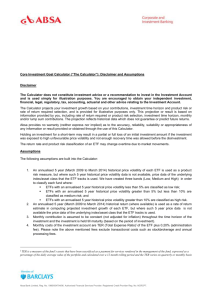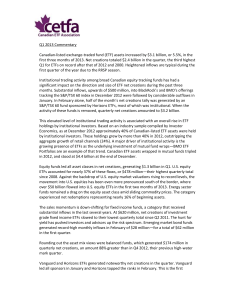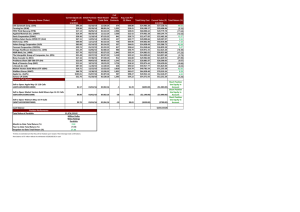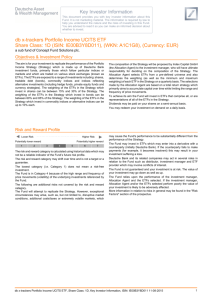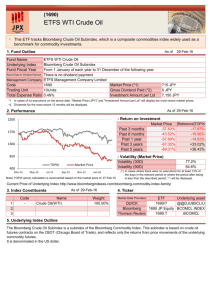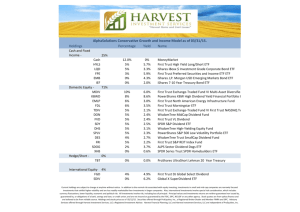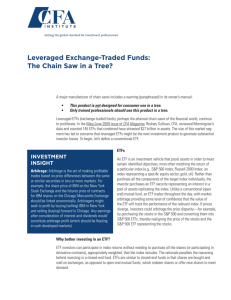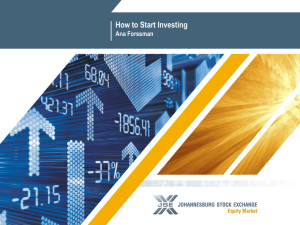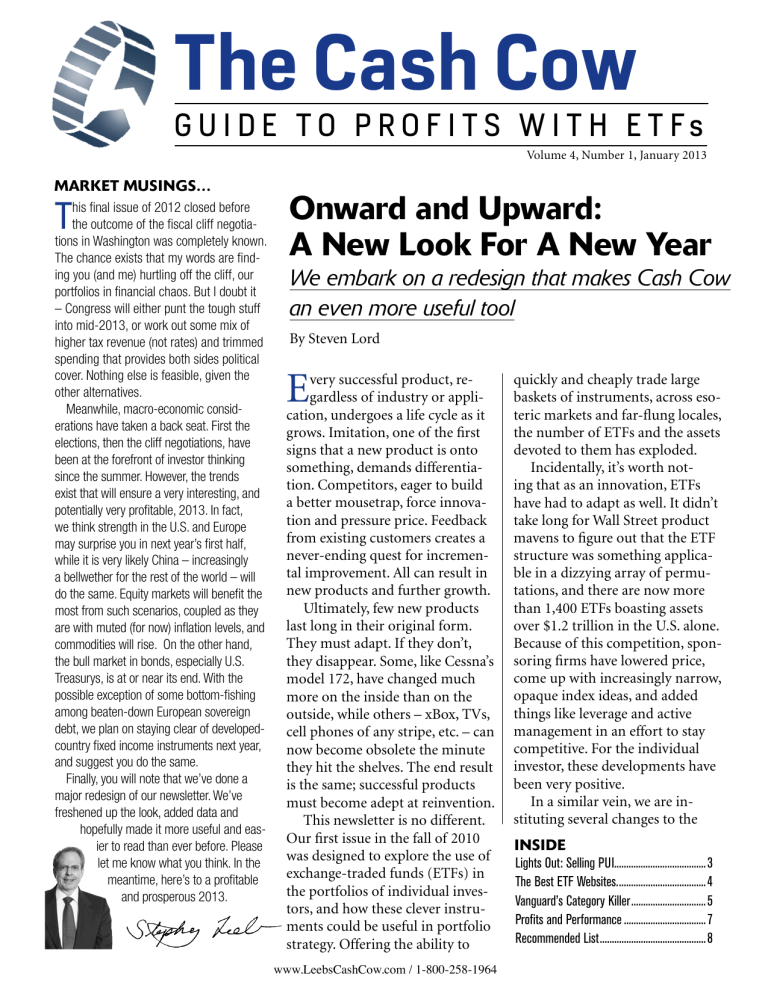
The Cash Cow
G u i d e t o P r o f i t s w i t h ETF s
Volume 4, Number 1, January 2013
Market musings…
T
his final issue of 2012 closed before
the outcome of the fiscal cliff negotiations in Washington was completely known.
The chance exists that my words are finding you (and me) hurtling off the cliff, our
portfolios in financial chaos. But I doubt it
– Congress will either punt the tough stuff
into mid-2013, or work out some mix of
higher tax revenue (not rates) and trimmed
spending that provides both sides political
cover. Nothing else is feasible, given the
other alternatives.
Meanwhile, macro-economic considerations have taken a back seat. First the
elections, then the cliff negotiations, have
been at the forefront of investor thinking
since the summer. However, the trends
exist that will ensure a very interesting, and
potentially very profitable, 2013. In fact,
we think strength in the U.S. and Europe
may surprise you in next year’s first half,
while it is very likely China – increasingly
a bellwether for the rest of the world – will
do the same. Equity markets will benefit the
most from such scenarios, coupled as they
are with muted (for now) inflation levels, and
commodities will rise. On the other hand,
the bull market in bonds, especially U.S.
Treasurys, is at or near its end. With the
possible exception of some bottom-fishing
among beaten-down European sovereign
debt, we plan on staying clear of developedcountry fixed income instruments next year,
and suggest you do the same.
Finally, you will note that we’ve done a
major redesign of our newsletter. We’ve
freshened up the look, added data and
hopefully made it more useful and easier to read than ever before. Please
let me know what you think. In the
meantime, here’s to a profitable
and prosperous 2013.
Onward and Upward:
A New Look For A New Year
We embark on a redesign that makes Cash Cow
an even more useful tool
By Steven Lord
E
very successful product, regardless of industry or application, undergoes a life cycle as it
grows. Imitation, one of the first
signs that a new product is onto
something, demands differentiation. Competitors, eager to build
a better mousetrap, force innovation and pressure price. Feedback
from existing customers creates a
never-ending quest for incremental improvement. All can result in
new products and further growth.
Ultimately, few new products
last long in their original form.
They must adapt. If they don’t,
they disappear. Some, like Cessna’s
model 172, have changed much
more on the inside than on the
outside, while others – xBox, TVs,
cell phones of any stripe, etc. – can
now become obsolete the minute
they hit the shelves. The end result
is the same; successful products
must become adept at reinvention.
This newsletter is no different.
Our first issue in the fall of 2010
was designed to explore the use of
exchange-traded funds (ETFs) in
the portfolios of individual investors, and how these clever instruments could be useful in portfolio
strategy. Offering the ability to
www.LeebsCashCow.com / 1-800-258-1964
quickly and cheaply trade large
baskets of instruments, across esoteric markets and far-flung locales,
the number of ETFs and the assets
devoted to them has exploded.
Incidentally, it’s worth noting that as an innovation, ETFs
have had to adapt as well. It didn’t
take long for Wall Street product
mavens to figure out that the ETF
structure was something applicable in a dizzying array of permutations, and there are now more
than 1,400 ETFs boasting assets
over $1.2 trillion in the U.S. alone.
Because of this competition, sponsoring firms have lowered price,
come up with increasingly narrow,
opaque index ideas, and added
things like leverage and active
management in an effort to stay
competitive. For the individual
investor, these developments have
been very positive.
In a similar vein, we are instituting several changes to the
INSIDE
Lights Out: Selling PUI...................................... 3
The Best ETF Websites...................................... 4
Vanguard’s Category Killer................................ 5
Profits and Performance................................... 7
Recommended List............................................. 8
The
Cash Cow
Currencies
and Commodities
format and layout of Cash Cow,
drawn mostly from subscriber
feedback and our own thinking
about what best serves our readers.
Our content will continue to be a
mix of macro-economic analysis,
trend identification and specific
ETF recommendations, but we’ve
improved the way it is presented
and added additional elements to
make it more useful.
One of the more significant
modifications is the way the newsletter is organized. We’ve consolidated our prior subject headings,
which included Commodities,
Currencies, Sectors, Income and
Emerging Markets, into three:
Income, Capital Appreciation and
Hard Assets/Hedge. Income, naturally, will include all ETFs whose
principal attraction is dividend,
distribution and/or coupon income, and whose recommendation
is based first and foremost on total
annual yield. Capital Appreciation
will feature ETFs of all types whose
main attraction to us is a rising
price, and Hard Asset/Hedge will
consist of ETFs whose positions
are predominantly physical metals,
commodities or other hard assets,
or that can serve specifically as a
hedge against volatility in equity,
bond or currency markets.
This step simplifies how our
recommendations and articles
are organized, and makes them
more aligned with the way investors actually use ETFs in their own
portfolios. In both our Capital Appreciation and Hard Assets/Hedge
sections, we plan on featuring
leveraged ETFs when appropriate and prudent to do so. In some
cases, our decision about where to
place an ETF may or may not be
The Cash Cow
yours – a high-yielding currency
ETF, for instance, could serve as an
income play or a hedge depending
on the individual investor. This is
to be expected, and doesn’t make
one or the other wrong. Our hope
is to give you one way of utilizing
a given ETF; there will obviously
be others.
We are also including more data
about each ETF we’re covering, as
well as specific advice about what
to do with each one. Importantly,
our best picks for new subscribers
or for those with new capital to deploy will be prominently featured.
ETF investors tend to be buy-andhold types by nature, so the goal
here is to give readers our thoughts
on the best ETFs to buy right now
in every issue.
In terms of content, we’re
adding ETF education to the list
of things we write about. Many
individual investors are unaware
of exactly how to use ETFs, as well
as the various tips and tricks available to maximize their benefits.
Many also do not know that all
ETFs are most certainly not created equal, and that major pitfalls
exist for the uninformed. We’ll
help de-mystify this asset class,
and help you better understand
what they can do for you.
Finally, we’ve also increased
the size of our graphics, added
some financial metrics to our
charts and made color, font & text
changes to make our newsletter
easier to read. The goal is to have
a publication that is at once easily
skimmed and also brimming with
useful information.
Hopefully, we’ve made Cash
Cow both more useful to our readers and ultimately of more value.
2
However, the ultimate test for any
product modification is whether
customers like it, so please contact us with your thoughts about
our first major face lift since we
launched. Send us an email to
cashcow@leeb.com, or visit www.
leebscashcow.com. v
The Cash Cow
Research Chairman: Stephen Leeb, Ph.D.
Publisher: Vicki Moffitt
Editor: Steven Lord
Managing Editor: Genia Turanova
Contributors:
Gregory Dorsey, David Sandell,
Kuen Chan, Genia Turanova
Creative Director: Ray Holland
Marketing Director: Matthew Warner
The Cash Cow, Stephen Leeb’s Guide to Currency &
Commodity Profits (ISSN: 2157-2011) is published
monthly by Fund World, LLC, 8 West 40th Street, New
York, NY 10018. Periodicals postage paid at New
York, NY, and additional mailing offices. The Cash
Cow, Stephen Leeb’s Guide to Currency & Commodity Profits, Volume 4, Number 1, 2013 by Fund World,
LLC, all rights reserved. The contents of this publication may not be reproduced in whole or in part without
consent of copyright owner. Subscription services (800)
258-1964 or write to The Cash Cow, PO Box 354, Williamsport PA 17703. Yearly subscription in USA: $199.
Canada and overseas: $259. POSTMASTER: Send address changes to The Cash Cow, Stephen Leeb’s Guide
to Currency & Commodity Profits, PO Box 354, Williamsport PA 17703. The Cash Cow, Stephen Leeb’s Guide to
Currency & Commodity Profits (LCC) is not registered
as a broker-dealer or investment adviser with the U.S.
Securities and Exchange Commission or any state securities authority. LCC and its information and content
providers make no representations or warranties of any
kind in connection with the subject matter of LCC or
the suitability of the information contained in LCC for
any purpose and are not liable for the timeliness, accuracy, or completeness of the information contained
herein. LCC is not responsible for any trades placed by
the recipients of LCC based on the information included
therein. Investment recommendations are not intended
to be construed as personal advice and readers should
consider their personal situation before making any investment. All opinions expressed and information and
data provided therein are subject to change without notice. LCC, its officers, directors, employees, associated
entities and/or clients of associated entities may currently maintain direct or indirect ownership positions in
financial instruments (i.e., stocks, bonds, options, warrants, etc.) whose underlying exposure is in the companies mentioned in LCC. Sources include Bloomberg,
Morningstar, Reuters and company/government data.
www.LeebsCashCow.com / 1-800-258-1964
January 2013
on the dividend bandwagon because special payouts need special
regulatory approval.
Nonetheless, both our utility
picks have done very well – PUI,
which yields 2.5 percent, is up over
One particular utility ETF provides all the sector
19 percent for us while XLU, which
yields 3.9 percent, has returned
exposure income investors need
over 14 percent. Both are focused
on the utility sector, but that’s
s expected, several of our
special and accelerated dividends
where the similarity ends. PUI
dividend-oriented ETF recom- that took place in the final weeks of
concentrates on the less-regulated,
mendations came under pressure
2012. Whether such steps are actufaster-growing side of the business,
during the recent fiscal cliff negoti- ally advantageous to investors is a
while XLU offers exposure to all
ations, with fears of higher tax rates matter of debate; special dividends
aspects of the utility industry. In
on payouts sending some investors
just shift capital from the balance
addition, PUI is a small as XLU is
in such instruments to the exits.
sheet to shareholders, who then see
large; the former has a mere
However, the impact was less
$40 million in assets, while the
Utilities Sector Select SPDR (XLU)
than many predicted; well over
later boasts over $4 billion.
39
half of all assets in dividendAccordingly, trading liquidity
38
generating equities (including
at XLU is much larger, making
37
ETFs) are held in tax-sheltered
it easier to trade, while XLU
accounts like 401Ks and IRAs,
36
charges a mere 0.18 percent
which means although tax concompared to PUI’s 0.63 per35
siderations make good press,
cent per year.
34
they’re not primary concern
Given these disparities, we
33
to a very large segment of the
suggest taking profits in PUI
32
income-investing public.
and keeping XLU. Of the two,
Dec-11
Apr-12
Aug-12
Dec-12
Moreover, investors are still
XLU gives you better expo$34.92
Yield
3.90%
facing a yield desert with limited Recent Price
sure to the utilities in PUI’s
AUM
$6.04B
ADV
6.9 mil.
ability to generate income. This
portfolio than the other way
Expense Ratio
0.18%
NAV
$34.92
means the market environment
around. We suggest parting
is strategically more important to
the price of the stock drop by the
with PUI and concentrating your
income investors than the tax struc- special dividend amount. No net
utility investments into the Vanture. Ultimately, dividends taxed at
new value is created. Nonetheless,
guard fund. It tracks the industry
higher rates are obviously preferable many companies even issued large
by investing in all 31 utility comto no dividends at all, an investing
amounts of debt in order to fund
panies in the S&P 500 and weights
truism loudly echoed by no one less
these one-time payouts, a dubious
them according to market capitalthan Warren Buffett. And note that
exercise in cost-benefit math if ever ization. XLU boasts four stars from
only those in the highest income
there was one.
Morningstar.
brackets (i.e. those least likely to be
One sector virtually absent from
What to do now: Sell PUI and
living off their portfolio income)
these shenanigans was Utilities,
book the gain. There is just no
will be dealing with the highest tax
represented in our recommended
reason to leave a 16% percent
rate in the first place.
list via Utilities Select Sector
gain on the table when a more
When all is said and done, we
SPDR (XLU) and PowerShares
liquid, higher-yielding and less
think the biggest impact of the
Dynamic Utilities (PUI). Due to
expensive alternative exists. If you
fiscal cliff on dividend stocks (and
their regulated nature, most utiliown XLU already, hold it; if you
their ETFs) will be the surge in
ties were precluded from jumping
don’t, buy it. v
Lights Out: We Part Ways
With One of Two Utility Picks
A
The Cash Cow
3
www.LeebsCashCow.com / 1-800-258-1964
The
Cash Cow
Currencies
and Commodities
ETFs. The three largest ETF families are Blackrock (iShares), State
Street and Vanguard, responsible for
over $1 trillion of the $1.4 trillion
in assets currently devoted to ETFs.
Other popular ones include Invesco
(PowerShares), Van Eck, ProShares,
and WisdomTree.
ProShares has become the top
shop for so-called “alternative” ETFs,
i.e. those that employ leverage, go
short, or hedge things like global
inflation or volatility. These ETFs
are among the most complicated
and riskiest out there, and while we
generally don’t think that the use of
the leverage, especially double- and
triple-leverage, is desirable (its use
often comes with too much of a
tracking error), some of these ETFs
can be useful for trading and/or
hedging. Of course, like any tool,
the more you understand them, the
better you can use them. And don’t
forget to review a prospectus before
investing; visit the ProShares website
for more.
A large number of web sites offer
data about any virtually listed ETF,
which is tremendously important
when researching a particular fund’s
portfolio positions, weightings,
underlying returns, and other information about the entire universe of
ETFs. These sites become important
when you are trying to determine
which ETF is the best way to play a
particular idea. Our list, in no particular order, appears nearby.
Note that general financial websites – wsj.com, Yahoo Finance, etc.
– are useful for ideas and some basic
data, but don’t expect many groundbreaking insights. Bloomberg has
news and a fairly strong screener
that helps you narrow down the
available choices. SeekingAlpha is
good for idea trolling – it boasts a
ton of articles written by investors,
but they’re usually no more adept
at ETF investing than anyone else.
Finally, of the data sites, we use
ETFdb.com and ETFchannel.com
the most – the former has the most
complete set of data points about
every ETF we have found, and the
latter has a useful function that lets
you search for which ETFs hold a
particular stock. v
4
www.LeebsCashCow.com / 1-800-258-1964
Tools of the Trade
We explore the best websites for research
and information on ETFs
E
xchange-traded funds are unique
instruments in numerous ways,
and are especially useful to individual
investors. Distinct from equities,
bonds and mutual funds, ETFs can
provide access to an investment
avenue or strategy otherwise unavailable, mitigate risk, and allow you to
speculate on whole sectors, currencies, commodities and countries via a
single position. And they’re universally quicker and less expensive to trade
than any comparable alternative. In
fact, the major reason why ETFs have
become so popular with individual
investors is that so much can be accomplished so easily for so little.
For all their utility, however, ETFs
are generally more complicated
that individual stocks or bonds. As
simple as the core concept may be,
investors continually misunderstand
things like an ETF’s portfolio construction, tax issues, use of leverage,
and tracking errors between an ETF
and its underlying index or instruments. And as the number and
complexity of ETF alternatives has
grown, the need for investors to do
some additional research has only
increased. By doing a little homework, you can ensure the ETF you
have just purchased will actually do
what you’d like it to, and that you
won’t get any nasty surprises.
Thankfully, there are resources
available. Not all are good, and many
are bland & superficial. However,
we’ve found a number to be useful,
especially in helping research fund
The Cash Cow
characteristics, news and relevant data.
Always start your research into a
new ETF at the sponsor’s home page.
Virtually all ETF families have fairly
comprehensive information about
their products available online,
including a prospectus and up-todate net asset values. Larger fund
families also offer background white
papers and other content related
to the types and strategies of their
Best ETF Web Sites
Etfdb.com
Morningstar.com
etfconnect.com
etftrends.com
finance.yahoo.com
indexuniverse.com
wsj.com
etfdailynews.com
seekingalpha.com
benzinga.com
bloomberg.com
etfchannel.com
January 2013
reason, many such funds are much
larger and less volatile than their
equivalent country-specific ones.
One broad emerging market
ETF that is attractive at the moment is also one of the biggest.
Vanguard’s massive fund offers broad exposure
Vanguard’s Emerging Markets
ETF (VWO) was one of the first
for low cost
emerging-market funds, and
boasts a whopping $56.8 bilnvestors look to emerging marfinancial sophistication, commod- lion in assets. Extraordinarily
diversified, VWO offers exposure
kets for a number of reasons,
ity consumption, etc. They might
to 22 countries and 890 equity
not the least of which has been
offer diversification benefits to an
positions, using a capitalizationthe theory that they provide iminvestor loaded with U.S. equities,
portant portfolio diversification.
but these markets are also popular weighted approach that favors the
largest companies regardless of
Prior to 2008, this diversification
because despite the swings, they
domicile at the expense of those
was thought to hedge U.S. equity
are the ones in which long-term
nations with larger economies
portfolios from a variety of risks,
growth is basically assured.
but smaller, less developed
including economic, currency
Vanguard MSCI Emerging Mkts (VWO) capital markets.
and market risk. Since the
After years tracking the
46
financial crisis, however, inMSCI Emerging Markets
vestors have learned the hard
44
Index, VWO is shifting to
way that emerging markets
42
the FTSE Emerging Markets
are not always as decoupled
40
Stock Index as its benchmark.
from developed ones as we
38
The major difference between
initially thought, especially
the two indices is South
36
in acute bearish phases. In
Korea – it makes up nearly 15
fact, they can be much more
34
percent of the MSCI Index
volatile, due to low liquidity,
32
but is not present the FTSE
Dec-11
Apr-12
Aug-12
Dec-12
meager share floats and rapid
Emerging Markets Index.
shifts in capital flows that can
Recent Price
$42.64
Yield
3.30%
However, over the past de$56.8 B
ADV
20.8 mil.
wreak havoc on even the most AUM
Expense Ratio
0.18%
NAV
$42.11
cade, the returns and volapromising emerging market.
tility measures of these two
On the other hand, when
indices have been essentially idenETFs have made accessing
risk appetite returns in force to
tical, suggesting the switch will
emerging markets easier and
global markets, emerging marhave minimal impact on VWO’s
kets can handily outperform
cheaper than ever before. Virtuperformance.
ally every large developing natheir more developed peers in
As one would expect from an
tion boasts at least one dedicated
the U.S., Japan and Europe. And
ETF
of this size and mandate,
ETF, and in many cases several.
in the background, it is useful
VWO heaviest concentrations are
Additionally, multi-market and
to remember that their volatility notwithstanding, emerging
regional ETFs have blossomed and in China, Korea, Brazil, Taiwan
and South Africa. 60 percent of
markets fundamentally have the
not only provide investors expothe fund’s assets are devoted to
sure to specific emerging counwind at their backs in terms of
Asian nations, and 21 percent to
tries, but diversify that exposure
growth in the number and wealth
Latin America. A further 10 perof high and middle-class consum- by spreading risk across a number
ers, infrastructure investment,
of nations and currencies. For this cent is dedicated to emerging na-
The Best All-Around
Emerging Market ETF
I
The Cash Cow
5
www.LeebsCashCow.com / 1-800-258-1964
The
Cash Cow
Currencies
and Commodities
ahead of themselves. Indeed, anations in Europe (primarily Russia) levels for a great one-stop option
in emerging markets.
and 8 percent to South Africa.
lysts estimate the industry has to
Sector exposure is concentrated
build 2.1-2.6 million new homes
n Meanwhile, we suggest taking
in Financials, at 24 percent of
in 2016 in order to justify current
profits in three of our capital apassets. This is unsurprising given
valuations, compared to annual
the tendency for banks, insurance
preciation plays. The “third rail”
pace of roughly 365,000 this year
companies and other financial
of our speculation on Canada,
and 1.3 million new homes in
services firms to be among the
iShares’ MSCI Canada Index
2005. The industry has to not
largest and most liquid equities in
(EWC), has returned just over 7
only surpass the pre-crisis peak, it
developing nations. Interestingly,
percent since our write-up last
has to do it in convincing fashion
Technology stocks are next, at 14
July, a respectable if not earthand in a much tougher lending
percent, although this number will shattering result. Weakness in
environment.
drop once South Korea (currently
commodities and strength in the
In other words, it’s not that we
14 percent of the portfolio)
don’t like the industry imis dropped from the portfomediate future; it’s that we
S&P Homebuilders SPDR (XHB)
lio. Consumer stocks account
think stock prices have already
29
for 16 percent of assets, with
discounted it. XHB did phe27
basic Materials and Energy at
nomenally well for us in 2012,
25
12.5 percent and 11.5 percent,
rising 28 percent since our
23
respectively.
recommendation in February,
21
Nearly 90 percent of VWO’s
and we’re not above booking a
19
positions are classified as
strong profit when one exists.
17
large- or mega-capitalization
We’ll return to XHB if prices
15
stocks. The average company
come off a bit. Sell.
13
in the fund has a market cap
Finally, take profits in MarDec-11
Apr-12
Aug-12
Dec-12
of over $18 billion, meanket Vectors Indonesia Index
Recent Price
$25.84
Yield
0.85%
ing this fund definitely has a
(IDX). Although Indonesia
AUM
$2.25 B
ADV
6.9 mil.
blue-chip tilt to it. This can be Expense Ratio
is a very interesting country
0.35%
NAV
$26.30
seen as an advantage, though,
from an emerging markets
U.S. dollar kept pressure on Casince larger companies in emergperspective, it is represented in
ing markets are typically dominanadian stocks through the second
both our new recommendation
half of 2012. Going forward, we
tors in their industries and have
Vanguard Emerging Markets
have exposure to Canada by way
significant entrenched advantages
ETF (VWO) as well as EGShares
of our mining & energy ETFs as
both economically and politically.
Emerging Markets Consumer
well as two of our currency recom- (ECON). We’ve been in IDX since
VWO’s top five positions make
up over 8.5 percent of the portmendations, so it is still fairly well
November 2010 and don’t have
represented in our list. Sell EWC.
folio, led by companies such as
much to show for it, so we sugWe also suggest selling our
Samsung, China Mobile, America
gest heading to the sidelines for
Movil and Taiwan Semiconductor. homebuilders ETF, S&P’s Homenow. We’ll return to Indonesia
We like VWO for its ability to
builders (XHB). Although seconce a stronger growth picture has
engage a broad swath of emergtor data is encouraging and we
returned.
believe the industry is still in the
ing market equity markets in one
What to do now: Buy Vanearly stages of a multi-year reETF. Typical of a Vanguard fund,
guard’s Emerging Markets ETF
expenses are kept to a minimum
covery, so many people have been (VWO). Sell iShares MSCI Canada
while trading liquidity is large
looking for a recovery in housing
Index (EWC), S&P Homebuilders
and bid-ask spread concerns are
stocks for so long, the stock prices (XHB) and Market Vectors Indoof U.S. homebuilders have gotten
nonexistent. Buy VWO at current
nesia Index (IDX). v
The Cash Cow
6
www.LeebsCashCow.com / 1-800-258-1964
January 2013
Profits and Performance
Our revised recommended list is easier to read
and follow
T
his issue marks the debut of
a new feature in Cash Cow
whose primary aim is to make our
advice easier to replicate in your
portfolios and thus a more useful
tool in your investment endeavors.
After all, that is the point of our
newsletter.
To this end, we will still be
speaking frankly about which of
our recommendations are working
well, which ones are not, and which
are our best ideas at the moment,
but now it will also be better reflected in the page 8 table. Our goal
remains for Cash Cow to become
an essential investment resource
for you instead of merely casual
reading.
Accordingly, we have been
trimming the number of recommendations carried by this service
in order to concentrate our ideas
into a smaller number of ETFs. Too
many picks essentially defeats the
purpose of this newsletter, which
is to help sort the over 1,400 ETFs
available into coherent and profitable investment ideas.
We keenly understand that the
sheer volume of choices can sometimes make it difficult to distill the
wheat from the chaff; going forward, we will have a much tighter
group of picks.
Our Recommended List on
page eight continues to be exactly
The Cash Cow
that – suggested additions and
deletions among the ETFs we are
favoring at the moment. We do
not expect every one of our ideas
will find its way into your portfolio, but rather those that fit your
personal goals, strategies and risk
tolerances.
If nothing else, we’d like Cash
Cow to give you new ideas about
ways to engage markets, sectors,
instruments, currencies and commodities using ETFs, one of the
cheapest and most versatile innovations to hit Wall Street in several
generations.
We’ve also instituted a system to
help both existing and new subscribers quickly determine our best
ideas at any given moment. Marked
with a star on the Recommended
List, these picks are what we con-
sider to be core holdings suitable
for just about any investor and
portfolio. These are the ones we’d
buy if we could only take a small
handful of our ideas – those we
believe will provide the best and/
or broadest exposure to the various
strategic trends unfolding in commodities, emerging markets, equity
and bond markets over the next
2-3 years. Additionally, these stars
signify which ETFs are the best
places to start for investors who are
new to our service or just getting
their feet wet with ETFs.
Finally, our recent position
closeouts appear nearby, with an
average 8.45 percent gain. The purpose of this table is to provide you
with a sense of our overall performance, since our Recommended
List only includes active recommendations. This also gives us a
way, albeit somewhat unscientific,
to measure the aggregate gain or
loss of our suggestions instead of
losing such information to eternity
once a recommendation has been
closed out. Over time, this system
will give us a way to measure Cash
Cow’s performance against a variety of well-known benchmarks. v
PAST Closeouts
iPath DJ-UBS Copper Total Return ETN (JJC)
-13.00%
iShares Barclays TIPS Bond (TIP)
6.80%
iShares Dow Jones US Pharmaceuticals (IHE)
18.70%
iShares S&P SmallCap 600 Growth (IJT)
21.70%
Market Vectors High Yield Municipal Bond (HYD)
22.80%
Market Vectors Oil Services (OIH)
8.10%
PIMCO Total Return (BOND)
5.00%
PowerShares DB Base Metals (DBB)
-13.70%
SPDR Technology Select Sector (XLK)
19.50%
Average: 8.45%
7
www.LeebsCashCow.com / 1-800-258-1964
Cash Cow Recommended List
Name/Symbol
Recom.
Date
January 2013
Recent
Price
Total
Return
Expense
Ratio Opinion
Annual
Yield
Notes
INCOME
iShares High Dividend Equity (HDV)
1/6/12
60.02
12.1%
0.40%
Hold
3.3%
Fiscal cliff pressured price
Dow Jones Intern. Real Estate (RWX)
9/5/12
41.40
8.6%
0.61%
Buy H
3.8%
Hit another 52-wk. high
iShares Floating Rate Note (FLOT)
8/6/12
50.46
0.9%
0.20%
Buy
1.0%
Stable as bonds rally again
iShares MSCI Australia Index Fund (EWA)
11/8/10
25.18
6.3%
0.52%
Buy
4.6%
Great yield, solid appr. Potential
iShares S&P U.S. Preferred Stock Index (PFF)
10/4/12
39.63
0.3%
0.48%
Buy
5.7%
Unique situation in pfd. stocks
PowerShares Dynamic Utilities (PUI)
8/4/11
17.27
15.5%
0.63%
SELL
2.7%
SELL
PowerShares International Dividend Acheivers (PID) 11/7/11
15.52
6.0%
0.59%
Hold
3.2%
Relative outperformance
S&P Emerging Markets Dividend (EDIV)
2/8/12
44.58
-11.6%
0.62%
Buy
5.9%
Continued bottom at $42-$44
Utilities Select Sector (XLU)
7/6/11
35.43
10.4%
0.18%
Hold
4.1%
Rebounding. See page 3
Vanguard Dividend Appreciation (VIG)
6/6/11
59.80
13.3%
0.18%
Buy H
2.1%
Best combo of yield + apprec.
Vanguard REIT Index (VNQ)
6/6/11
64.97
14.6%
0.12%
Buy
3.4%
RE uptrend gaining steam
Average position return: 6.94%
Hard Assets/Hedge CurrencyShares Australian Dollar Trust (FXA)
10/12/10
104.89
14.7%
0.40%
Hold
Steady in spite of new interest rate cut
CurrencyShares Canadian Dollar Trust (FXC)
9/7/11
100.31
-0.4%
0.40%
Buy
Highly correlated to commodity moves
ETFS Physical Platinum Shares (PPLT)
9/14/10
157.18
-0.9%
0.60%
Buy
Outshining gold and silver at the moment
iShares Silver Trust (SLV)
4/5/11
31.93
-16.7%
0.50%
Buy
Correcting from $36. Weaker $ will help
PowerShares DB Commodity Index (DBC)
10/12/10
27.64
9.9%
0.93%
Buy H
PowerShares DB G10 Currency Harvest (DBV)
9/14/10
26.02
13.9%
0.81%
Buy
New 52-wk high on weaker USD
ProShares UltraShort Yen ETF (YCS)
3/7/12
45.86
1.1%
0.95%
Buy
Trend shift has held; Next stop $48
SPDR Gold Shares (GLD)
9/14/10
164.50
32.6%
0.40%
Buy H
Core ETF holding as inflation hedge
Vanguard Extended Duration Treasury Index (EDV)
10/4/11
128.47
7.1%
0.13%
Hold
Yields 2.8%. Rallied during fiscal cliff
WisdomTree Dreyfus Brazilian Real Fund (BZF)
9/14/10
18.60
-5.4%
0.45%
Buy
Continued flat; NAV over $29
Sector rotation will benefit this ETF
Average position return: 5.6%
Capital Appreciation
Consumer Staples Select Sector (XLP)
5/3/12
35.93
6.1%
0.18%
Buy
Good defensive play + good upside
EGShares China Infrastructure (CHXX)
6/5/12
18.80
22.3%
0.85%
Hold
Signs of China rebound increasing
EGShares Emerging Mkts Consumer (ECON)
9/5/12
25.76
11.3%
0.85%
Buy
New 52-wk high. Excellent LT play
First Trust ISE Global Copper Index (CU)
1/6/12
29.20
-2.1%
0.70%
Buy
Copper at 6-mo. High on China econ.
iShares Latin America 40 Index (ILF)
3/7/12
42.33
-9.2%
0.50%
Buy
Yields 3.1%. Best Lat. Amer. ETF avail.
iShares MSCI Brazil Index Fund (EWZ)
12/7/11
52.77
-11.2%
0.59%
SELL
SELL
iShares MSCI Canada Index (EWC)
7/3/12
28.13
5.8%
0.52%
SELL
SELL
iShares MSCI Switzerland Index (EWL)
9/5/12
26.31
10.3%
0.52%
Hold
New 52-wk high. Strong inflows in Dec.
iShares MSCI Thailand Invest. Market Index (THD)
11/8/10
78.50
10.9%
0.60%
Buy
New 52-wk high. Top Asian market
iShares MSCI Turkey Invest Mkt Index (TUR)
5/3/12
64.08
27.8%
0.59%
Buy
New 52.-wk high. Top Emerging market
iShares MSCI United Kingdom Index (EWU)
1/6/12
17.83
12.3%
0.52%
Hold
Yields 3.5%. Great global exposure
Market Vectors Agribusiness (MOO)
1/6/12
52.02
6.6%
0.53%
Buy
Relative strength vs. rest of equity mkt.
Market Vectors Indonesia Index (IDX)
11/8/10
28.54
-3.7%
0.61%
SELL
SELL
Market Vectors Morningstar Wide Moat (MOAT)
6/5/12
21.83
18.0%
0.49%
Buy H
Large-caps with competitive advantages
S&P Biotech Select Sector(XBI)
8/5/11
87.65
1.8%
0.35%
Buy
S&P Energy Select Sector (XLE)
7/3/12
71.13
5.1%
0.18%
Buy H
Top energy ETF for multi-mkt exposure
S&P Homebuilders (XHB)
2/7/12
25.57
27.9%
0.35%
SELL
SELL
Vanguard Emerging Markets ETF (VWO)
12/7/12
42.89
New
0.18%
Buy
Largest emerging market fund available
Average position return: 8.2%
Data as of 12/06/12 Bold = mentioned in this issue H = Buy “first” pick for new subscribers
Volatile at end of year; buy on dips

